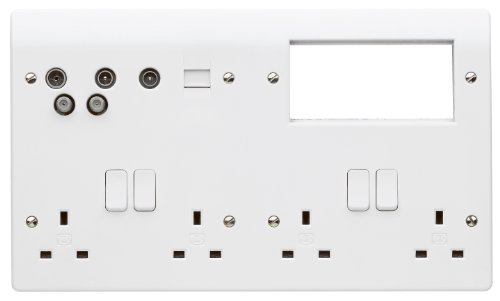Hey folks,
Next weekend I am embarking on starting to build a false wall for my new tele however I have a few questions to ask so that things can run as smoothly as possible.
I have done a lot of my own research about this project but I just wanted to clarify a few things.
Firstly the diagram:

As you can see the current 2 gang socket location is to the right of the wall. I am wishing to extend the current cabling to behind the false wall to hopeful add 3 x 2 gang sockets I am also wanting to put a 1 gang socket about a third of the way up.
Extending the original cable:
Now my three options I have considered are to-
1) remove the cabling from the socket and use a wagobox under the floor boards (I am aware hiding connections is a big no no but have been informed that this is acceptable as they do not need to be maintained although please correct me)
2) keep the original socket and extend the cabling from that although I do not want to overload the current circuitry.
3) cover the original socket with a blanking plate then extend the existing wire with a crimp connector (again have been told this is ok so long as it is accessible)
I know that all new cables run have to be in the 'safe zone'. Running new cables from fuse box is not ideal as the rest of the flat has just been decorated.
Adding additional sockets to the current circuitry:
Simple really. How many extra sockets can I add to the circuitry and would I have to do anything to the existing fuse board?
If there is any other information you require for you guys and gals to help with this please let me know.
Many thanks in advance
Si
Next weekend I am embarking on starting to build a false wall for my new tele however I have a few questions to ask so that things can run as smoothly as possible.
I have done a lot of my own research about this project but I just wanted to clarify a few things.
Firstly the diagram:

As you can see the current 2 gang socket location is to the right of the wall. I am wishing to extend the current cabling to behind the false wall to hopeful add 3 x 2 gang sockets I am also wanting to put a 1 gang socket about a third of the way up.
Extending the original cable:
Now my three options I have considered are to-
1) remove the cabling from the socket and use a wagobox under the floor boards (I am aware hiding connections is a big no no but have been informed that this is acceptable as they do not need to be maintained although please correct me)
2) keep the original socket and extend the cabling from that although I do not want to overload the current circuitry.
3) cover the original socket with a blanking plate then extend the existing wire with a crimp connector (again have been told this is ok so long as it is accessible)
I know that all new cables run have to be in the 'safe zone'. Running new cables from fuse box is not ideal as the rest of the flat has just been decorated.
Adding additional sockets to the current circuitry:
Simple really. How many extra sockets can I add to the circuitry and would I have to do anything to the existing fuse board?
If there is any other information you require for you guys and gals to help with this please let me know.
Many thanks in advance
Si






